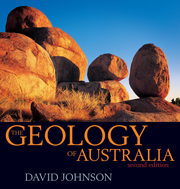Book contents
- Frontmatter
- Contents
- Map
- Preface
- Acknowledgements
- Map of main localities mentioned
- Abbreviations and units
- 1 An Australian perspective
- 2 The Earth: A geology primer
- 3 Building the core of Precambrian rocks
- 4 Warm times: Tropical corals and arid lands
- 5 Icehouse: Carboniferous and Permian glaciation
- 6 Mesozoic warming: The great inland plains and seas
- 7 Birth of modern Australia: Flowering plants, mammals and deserts
- 8 The history and evolution of life on Earth
- 9 Eastern highlands and volcanoes barely extinct
- 10 Building the continental shelf and coastlines
- 11 Great Barrier Reef
- 12 Planets, moons, meteorites and impact craters
- 13 A geological perspective on climate change
- 14 Cycles in a continental journey
- Sources and references
- Figure sources
- Index
4 - Warm times: Tropical corals and arid lands
Published online by Cambridge University Press: 05 August 2013
- Frontmatter
- Contents
- Map
- Preface
- Acknowledgements
- Map of main localities mentioned
- Abbreviations and units
- 1 An Australian perspective
- 2 The Earth: A geology primer
- 3 Building the core of Precambrian rocks
- 4 Warm times: Tropical corals and arid lands
- 5 Icehouse: Carboniferous and Permian glaciation
- 6 Mesozoic warming: The great inland plains and seas
- 7 Birth of modern Australia: Flowering plants, mammals and deserts
- 8 The history and evolution of life on Earth
- 9 Eastern highlands and volcanoes barely extinct
- 10 Building the continental shelf and coastlines
- 11 Great Barrier Reef
- 12 Planets, moons, meteorites and impact craters
- 13 A geological perspective on climate change
- 14 Cycles in a continental journey
- Sources and references
- Figure sources
- Index
Summary
After the enormous time span of the Precambrian, lasting 4000 million years, complex life suddenly burst forth in an astonishing array within a few million years. What types were there? And onto what sort of Earth did they evolve?
The span of this chapter covers 191 million years, comprising:
54 million years in the Cambrian 542–488 Ma
44 million years in the Ordovician 488–444 Ma
28 million years in the Silurian 444–416 Ma
57 million years in the Devonian 416–359 Ma.
PART OF GONDWANA
For this time, from 542–359 Ma ago, there was still no Australia as we know it. The present Australia was just a segment on the northern edge of Gondwana. The Australian segment did not lie east–west, but north–south, with western and central Australia embedded in the supercontinent, and being eroded. An open ocean lay across what is now eastern Australia.
Gondwana consisted of large onshore areas, huge chains of active volcanoes, with embayments of shallow seas and coral reefs, passing offshore into deep water. A possible modern analogy is the American landmass with the shallow Caribbean Sea and reefs, the volcanic arc of the West Indies, and the deep waters of the Atlantic.
The present landmass that is eastern Australia was not made at that time. There is a line that can be drawn from the present western side of Princess Charlotte Bay through southwestern Queensland and into far northeastern South Australia, with a sharp turn into New South Wales, southeast again to take in Broken Hill, and finally a dogleg west to Kangaroo Island in South Australia.
- Type
- Chapter
- Information
- The Geology of Australia , pp. 89 - 104Publisher: Cambridge University PressPrint publication year: 2009



